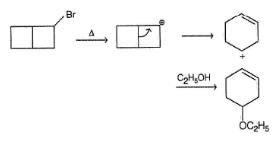Class 12 Exam > Class 12 Questions > Following compound when heated in ethanol, SN...
Start Learning for Free
Following compound when heated in ethanol, SN1 reaction occur involving rearrangement of carbocation.
Q.
In the major product, how many carbon atoms are present in the single largest ring?
Correct answer is '6'. Can you explain this answer?
Verified Answer
Following compound when heated in ethanol, SN1 reaction occur involvin...

 This question is part of UPSC exam. View all Class 12 courses
This question is part of UPSC exam. View all Class 12 courses

|
Explore Courses for Class 12 exam
|

|
Similar Class 12 Doubts
Following compound when heated in ethanol, SN1 reaction occur involving rearrangement of carbocation.Q.In the major product, how many carbon atoms are present in the single largest ring?Correct answer is '6'. Can you explain this answer?
Question Description
Following compound when heated in ethanol, SN1 reaction occur involving rearrangement of carbocation.Q.In the major product, how many carbon atoms are present in the single largest ring?Correct answer is '6'. Can you explain this answer? for Class 12 2024 is part of Class 12 preparation. The Question and answers have been prepared according to the Class 12 exam syllabus. Information about Following compound when heated in ethanol, SN1 reaction occur involving rearrangement of carbocation.Q.In the major product, how many carbon atoms are present in the single largest ring?Correct answer is '6'. Can you explain this answer? covers all topics & solutions for Class 12 2024 Exam. Find important definitions, questions, meanings, examples, exercises and tests below for Following compound when heated in ethanol, SN1 reaction occur involving rearrangement of carbocation.Q.In the major product, how many carbon atoms are present in the single largest ring?Correct answer is '6'. Can you explain this answer?.
Following compound when heated in ethanol, SN1 reaction occur involving rearrangement of carbocation.Q.In the major product, how many carbon atoms are present in the single largest ring?Correct answer is '6'. Can you explain this answer? for Class 12 2024 is part of Class 12 preparation. The Question and answers have been prepared according to the Class 12 exam syllabus. Information about Following compound when heated in ethanol, SN1 reaction occur involving rearrangement of carbocation.Q.In the major product, how many carbon atoms are present in the single largest ring?Correct answer is '6'. Can you explain this answer? covers all topics & solutions for Class 12 2024 Exam. Find important definitions, questions, meanings, examples, exercises and tests below for Following compound when heated in ethanol, SN1 reaction occur involving rearrangement of carbocation.Q.In the major product, how many carbon atoms are present in the single largest ring?Correct answer is '6'. Can you explain this answer?.
Solutions for Following compound when heated in ethanol, SN1 reaction occur involving rearrangement of carbocation.Q.In the major product, how many carbon atoms are present in the single largest ring?Correct answer is '6'. Can you explain this answer? in English & in Hindi are available as part of our courses for Class 12.
Download more important topics, notes, lectures and mock test series for Class 12 Exam by signing up for free.
Here you can find the meaning of Following compound when heated in ethanol, SN1 reaction occur involving rearrangement of carbocation.Q.In the major product, how many carbon atoms are present in the single largest ring?Correct answer is '6'. Can you explain this answer? defined & explained in the simplest way possible. Besides giving the explanation of
Following compound when heated in ethanol, SN1 reaction occur involving rearrangement of carbocation.Q.In the major product, how many carbon atoms are present in the single largest ring?Correct answer is '6'. Can you explain this answer?, a detailed solution for Following compound when heated in ethanol, SN1 reaction occur involving rearrangement of carbocation.Q.In the major product, how many carbon atoms are present in the single largest ring?Correct answer is '6'. Can you explain this answer? has been provided alongside types of Following compound when heated in ethanol, SN1 reaction occur involving rearrangement of carbocation.Q.In the major product, how many carbon atoms are present in the single largest ring?Correct answer is '6'. Can you explain this answer? theory, EduRev gives you an
ample number of questions to practice Following compound when heated in ethanol, SN1 reaction occur involving rearrangement of carbocation.Q.In the major product, how many carbon atoms are present in the single largest ring?Correct answer is '6'. Can you explain this answer? tests, examples and also practice Class 12 tests.

|
Explore Courses for Class 12 exam
|

|
Signup for Free!
Signup to see your scores go up within 7 days! Learn & Practice with 1000+ FREE Notes, Videos & Tests.



















